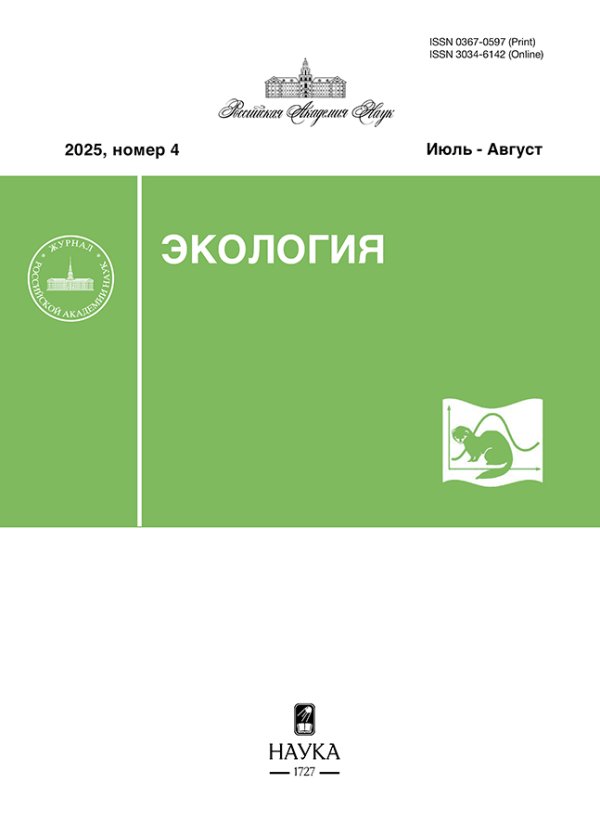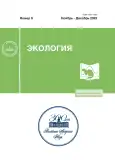Реакция населения беспозвоночных остепненных и пойменных лугов на выбросы Карабашского медеплавильного завода
- Авторы: Нестерков А.В.1, Нестеркова Д.В.1
-
Учреждения:
- Институт экологии растений и животных УрО РАН
- Выпуск: № 6 (2023)
- Страницы: 470-480
- Раздел: Статьи
- URL: https://gynecology.orscience.ru/0367-0597/article/view/673039
- DOI: https://doi.org/10.31857/S0367059723060057
- EDN: https://elibrary.ru/BLQOER
- ID: 673039
Цитировать
Полный текст
Аннотация
По материалам 2014 г. оценена реакция сообществ беспозвоночных пойменных и остепненных лугов на выбросы Карабашского медеплавильного завода (основные поллютанты – SO2 и тяжелые металлы). Вблизи завода в фитоценозах лугов обоих типов снижается фитомасса разнотравья (в 2–7 раз) и возрастает доля граминоидов (с 36–45 до 53–85%). Обилие беспозвоночных на лугах обоих типов меняется сходно: общее обилие снижается (в 1.4–2.9 раза), тогда как обилие всех трофических и большей части крупных таксономических групп не изменяется. Таксономическая структура беспозвоночных на пойменных лугах изменялась только в импактной зоне, а на остепненных – уже в буферной. Этот результат частично подтверждает выдвинутую гипотезу о том, что в сообществах пойменных лугов реакция на загрязнение выражена слабее, чем в остепненных.
Ключевые слова
Об авторах
А. В. Нестерков
Институт экологии растений и животных УрО РАН
Email: nesterkov@ipae.uran.ru
Россия, 620144, Екатеринбург, ул. 8 Марта, 202
Д. В. Нестеркова
Институт экологии растений и животных УрО РАН
Автор, ответственный за переписку.
Email: nesterkov@ipae.uran.ru
Россия, 620144, Екатеринбург, ул. 8 Марта, 202
Список литературы
- Чернов Ю.И., Руденская Л.В. Комплекс беспозвоночных – обитателей травостоя как ярус животного населения // Зоол. журн. 1975. Т. 54. Вып. 6. С. 884–894.
- Нестерков А.В., Воробейчик Е.Л. Изменение структуры населения беспозвоночных-хортобионтов под действием выбросов медеплавильного завода // Экология. 2009. № 4. С. 303–313 [Nesterkov A.V., Vorobeichik E.L. Changes in the structure of chortobiont invertebrate community exposed to emissions from a copper smelter // Russ. J. Ecol. 2009. V. 40. № 4. P. 286–296.]
- Золотарев М.П., Нестерков А.В. Паукообразные (Aranei, Opiliones) лугов: Реакция на загрязнение выбросами Среднеуральского медеплавильного комбината // Экология. 2015. № 1. С. 48–56. [Zolotarev M.P., Nesterkov A.V. Arachnids (Aranei, Opiliones) in meadows: Response to pollution with emissions from the Middle Ural Copper Smelter // Russ. J. Ecol. 2015. V. 46. № 1. P. 81–88.]
- Нестерков А.В. Признаки восстановления сообществ беспозвоночных травостоя после снижения выбросов медеплавильного завода // Экология. 2022. № 6. P. 468–478. [Nesterkov A.V. Recovery signs in grass-stand invertebrate communities after a decrease in copper-smelting emissions // Russ. J. Ecol. 2022. V. 53. № 6. P. 553–564.]
- Hunter B.A., Johnson M.S., Thompson D.J. Ecotoxicology of copper and cadmium in a contaminated grassland ecosystem. II. Invertebrates // Journal of Applied Ecology. 1987. V. 24. № 2. P. 587–599.
- Perner J., Voigt W., Bährmann R. et al. Responses of arthropods to plant diversity // Ecography. 2003. V. 26. № 6. P. 788–800.
- Заключение экспертной комиссии по рассмотрению материалов оценки степени экологического неблагополучия окружающей среды и состояния здоровья населения и проекта Федеральной целевой программы первоочередных неотложных мер на 1996–2000 гг. по выводу территории г. Карабаша Челябинской области из состояния экологического бедствия и оздоровлению населения. https://docs.cntd.ru/document/9035640
- Lightfoot D.C., Whitford W.G. Productivity of creosotebush foliage and associated canopy arthropods along a desert roadside // American Midland Naturalist. 1991. V. 125. P. 310–322.
- D’Odorico P., Bhattachan A. Hydrologic variability in dryland regions // Philosophical Transactions of the Royal Society B: Biological Sciences. 2012. V. 367. P. 3145–3157.
- Schowalter T.D., Lightfoot D., Whitford W. Diversity of arthropod responses to host-plant water stress in a desert ecosystem in southern New Mexico // American Midland Naturalist. 1999. V. 142. P. 281–290.
- Zhu H., Wang D.L., Wang L. et al. Effects of altered precipitation on insect community composition and structure in a meadow steppe // Ecological Entomology. 2014. V. 39. № 4. P. 453–461.
- Wenninger E.J., Inouye R.S. Insect community response to plant diversity and productivity in a sagebrush-steppe ecosystem // Journal of Arid Environments. 2008. V. 72. № 1. P. 24–33.
- Warrington S., Whittaker J.B. Interactions between sitka spruce, the green spruce aphid, sulphur-dioxide pollution and drought // Environmental Pollution. 1990. V. 65. № 4. P. 363–370.
- Burkhardt J., Pariyar S. Particulate pollutants are capable to ‘degrade’ epicuticular waxes and to decrease the drought tolerance of Scots pine (Pinus sylvestris L.) // Environmental Pollution. 2014. V. 184. P. 659–667.
- Sediment dynamics and pollutant mobility in rivers. Berlin, Heidelberg: Springer-Verlag, 2007. 430 p.
- Sivakumar S. Effects of metals on earthworm life cycles // Environmental Monitoring and Assessment. 2015. V. 187. № 8. P.1–16.
- Klok C., Kraak M.H.S. Living in highly dynamic polluted river floodplains, do contaminants contribute to population and community effects? // Science of the Total Environment. 2008. V. 406. № 3. P. 455–461.
- Schipper A.M., Hendriks A.J., Ragas A.M.J. et al. Disentangling and ranking the influences of multiple environmental factors on plant and soil-dwelling arthropod assemblages in a river Rhine floodplain area // Hydrobiologia. 2014. V. 729. № 1. P. 133–142.
- Purvis O.W., Chimonides P.J., Jones G.C. et al. Lichen biomonitoring near Karabash Smelter Town, Ural Mountains, Russia, one of the most polluted areas in the world // Proceedings of the Royal Society B: Biological Sciences. 2003. V. 271. P. 221–226.
- Smorkalov I.A., Vorobeichik E.L. Does long-term industrial pollution affect the fine and coarse root mass in forests? // Water Air and Soil Pollution. 2022. V. 233. № 2. P. 55.
- Нестерков А.В. Опыт использования биоценометра с вакуумным пробосборником для учета беспозвоночных травостоя // Евразиатский энтомологич. журн. 2014. Т. 13. № 3. С. 244–245.
- R Core Team. R: a language and environment for statistical computing. https://www.R-project.org/.
- Fox J., Weisberg S. An {R} companion to applied regression. https://socialsciences.mcmaster.ca/jfox/-Books/Companion/.
- Tremblay A., Ransijn J. LMERConvenienceFunctions: Model selection and post-hoc analysis for (G)LMER models. R package version 3.0. https://CRAN.R-project.org/package=LMERConvenienceFunctions.
- Hothorn T., Bretz F., Westfall P. Simultaneous inference in general parametric models // Biometrical Journal. 2008. V. 50. № 3. P. 346–363.
- Pustejovsky J.E., Chen M., Swan D.M. SingleCaseES: A calculator for single-case effect sizes. R package version 0.6.1. https://CRAN.R-project.org/package=SingleCaseES.
- Begueria S., Vicente-Serrano S.M. SPEI: Calculation of the standardised precipitation-evapotranspiration index. R package version 1.7. https://CRAN.R-project.org/package=SPEI.
- Расписание погоды. Информация о погодных условиях метеостанции г. Челябинск (синоптический индекс станции – 28630). https://www.rp5.ru.
- Wickham H. ggplot2: Elegant graphics for data analysis. New York: Springer-Verlag, 2016. 260 p.
- Suzuki R., Terada Y., Shimodaira H. pvclust: Hierarchical clustering with P-values via multiscale bootstrap resampling. R package version 2.2-0. https://CRAN.R-project.org/package=pvclust.
- Zvereva E., Kozlov M. Changes in the abundance of vascular plants under the impact of industrial air pollution // Water Air and Soil Pollution. 2011. Online publication. P. 1–11.
- Воробейчик Е.Л., Садыков О.Ф., Фарафонтов М.Г. Экологическое нормирование техногенных загрязнений наземных экосистем. Екатеринбург: Наука, 1994. 280 с.
- Воробейчик Е.Л., Трубина М.Р., Хантемирова Е.В. и др. Многолетняя динамика лесной растительности в период сокращения выбросов медеплавильного завода // Экология. 2014. № 6. С. 448–458. [Vorobeichik E.L., Trubina M.R., Khantemirova E.V. et al. Long-term dynamic of forest vegetation after reduction of copper smelter emissions // Russ. J. Ecol. 2014. V. 45. № 6. P. 498–507.]
- Hunter B.A., Johnson M.S., Thompson D.J. Ecotoxicology of copper and cadmium in a contaminated grassland ecosystem. I. Soil and vegetation contamination // Journal of Applied Ecology. 1987. V. 24. № 2. P. 573–586.
- Zvereva E., Kozlov M. Responses of terrestrial arthropods to air pollution // Environmental Science and Pollution Research. 2010. V. 17. № 2. P. 297–311.
- Воробейчик Е.Л., Ермаков А.И., Золотарев М.П. и др. Изменение разнообразия почвенной мезофауны в градиенте промышленного загрязнения // Русский энтомологич. журн. 2012. № 21. С. 203–218.
- Воробейчик Е.Л., Ермаков А.И., Гребенников М.Е. Начальные этапы восстановления сообществ почвенной мезофауны после сокращения выбросов медеплавильного завода // Экология. 2019. № 2. С. 133–148. [Vorobeichik E.L., Ermakov A.I., Grebennikov M.E. Initial stages of recovery of soil macrofauna communities after reduction of emissions from a copper smelter // Russ. J. Ecol. 2019. V. 50. № 2. P. 146–160.]
- Ермаков А.И. Изменение комплекса некрофильных беспозвоночных под действием загрязнения выбросами Среднеуральского медеплавильного завода // Экология. 2013. № 6. С. 1–8. [Ermakov A.I. Changes in the assemblage of necrophilous invertebrates under the effect of pollution with emissions from the Middle Ural Copper Smelter // Russ. J. Ecol. 2013. V. 44. № 6. P. 515–522.]
- Бельская Е.А., Зиновьев Е.В. Структура комплексов жужелиц (Coleoptera, Carabidae) в природных и техногенно-нарушенных лесных экосистемах на юго-западе Свердловской области // Сибирский экологич. журн. 2007. № 4. С. 533–543.
- Золотарев М.П. Изменение таксономической структуры населения паукообразных-герпетобионтов в градиенте загрязнения от выбросов медеплавильного комбината // Экология. 2009. № 5. С. 378–382. [Zolotarev M.P. Changes in the taxonomic structure of herpetobiont arachnids along the gradient of pollution with emissions from a copper smelter // Russ. J. Ecol. 2009. V. 40. № 5. P. 356–360.]
- Бельская Е.А. Динамика трофической активности филлофагов березы в период снижения атмосферных выбросов медеплавильного завода // Экология. 2018. № 1. С. 74–80. [Belskaya E. Dynamics of trophic activity of leaf-eating insects on birch during reduction of emissions from the Middle Ural Copper Smelter // Russ. J. Ecol. 2018. V. 49. № 1. P. 87–92.]
- Haddad N.M., Crutsinger G.M., Gross K. et al. Plant species loss decreases arthropod diversity and shifts trophic structure // Ecology Letters. 2009. V. 12. № 10. P. 1029–1039.
- Schaffers A.P., Raemakers I.P., Sýkora K.V. et al. Arthropod assemblages are best predicted by plant species composition // Ecology. 2008. V. 89. № 3. P. 782–794.
- Dulya O.V., Mikryukov V.S., Hlystov I.A. Interspecific differences in determinants of plant distribution in industrially polluted areas // Plant and Soil. 2015. V. 394. № 1–2. P. 329–342.
- Дуля О.В., Микрюков В.С., Воробейчик Е.Л. Стратегии адаптации Deschampsia caespitosa и Lychnis flos-cuculi к загрязнению тяжелыми металлами: Анализ на основе зависимости доза–эффект // Экология. 2013. № 4. С. 243–253. [Dulya O.V., Mikryukov V.S., Vorobeichik E.L. Strategies of adaptation to heavy metal pollution in Deschampsia caespitosa and Lychnis flos-cuculi: Analysis based on dose-response relationship // Russ. J. Ecol. 2013. V. 44. № 4. P. 271–281.]
- Dahmani-Muller H., van Oort F., Gelie B. et al. Strategies of heavy metal uptake by three plant species growing near a metal smelter // Environmental Pollution. 2000. V. 109. № 2. P. 231–238.
- Naiman R., Decamps H. The ecology of interfaces // Annual Review of Ecology and Systematics. 1997. V. 28. P. 621–658.
- Wang S., Wei M., Cheng H. et al. Indigenous plant species and invasive alien species tend to diverge functionally under heavy metal pollution and drought stress // Ecotoxicology and Environmental Safety. 2020. V. 205. P. 111160.
- Jhee E.M., Boyd R.S., Eubanks M.D. Nickel hyperaccumulation as an elemental defense of Streptanthus polygaloides (Brassicaceae) // New Phytologist. 2005. V. 168. № 2. P. 331–343.
- Lindqvist L., Block M., Tjälve H. Distribution and excretion of Cd, Hg, methyl-Hg and Zn in the predatory beetle Pterostichus niger (Coleoptera: Carabidae) // Environmental Toxicology and Chemistry. 1995. V. 14. P. 1195–1201.
- Vickerman D.B., Trumble J.T. Biotransfer of selenium // Ecotoxicology. 2003. V. 12. № 6. P. 497–504.
Дополнительные файлы












